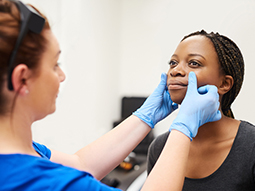After cosmetic surgery, you may want to jump back into the swing of things. But it can be difficult to head back to work or engage in regular social activities when you still have visible swelling, bruising, or incision marks. These can last days, weeks, or even months. But you don’t need to sit at home and wait. Makeup products and techniques can be used by men and women to camouflage the temporary side effects of surgery and boost your confidence.
Your surgeon can introduce you to the kinds of products available and show you how to use them. Ask him or her when you can start applying makeup after your surgery. Most people can begin applying makeup as early as a day or two after surgery. Hiding incision lines may need to wait until the stitches are removed and the incision is completely closed.
Camouflage products
Special camouflage products can be recommended by your surgeon that are fragrance-free and less likely to cause adverse reactions when applied to your skin. But you may be able to use the same makeup you currently use — just be sure to buy fresh products with new applicators so they will be as clean as possible.
There are three basic types of camouflage makeup concepts:
- Concealing helps hide bruises and incision lines. Concealers are thicker than regular foundation makeup. Try to find one that closely matches your skin tone and avoid using concealer near the eyes. Due to the thin, delicate skin near the eyes, a normal fluid foundation, color corrector, or eye makeup may work best.
- Color correcting tones down the color of skin that appears more red or yellow than usual. A lavender-tinted color corrector helps with yellow tones while a green-tinted corrector helps cover up red.
- Contouring helps hide swelling. It works by using foundation makeup that is lighter and darker than the foundation color you’d normally use. The lighter product will bring forward parts of your face, while the darker product will recede others. You’ll need to blend these colors together to create the illusion of angles without seeing stripes of makeup. This can take practice, but once you are skilled at it, you can easily minimize swollen parts of your face.
Because camouflage cosmetics tend to be thicker and more adherent than everyday makeup, it’s important that you remove them every night. Use a cleansing cream, alcohol-free toner, and moisturizer every night while using these cosmetics to maintain your skin’s health.
Our providers

Expert plastic surgery care
Getting the care you need starts with seeing one of our cosmetic surgeons.
Our locations
Distance from Change locationEnter your location
MedStar Health: Plastic Surgery at MedStar Georgetown University Hospital
3800 Reservoir Road NW, BLES Building 1st. Floor Washington, D.C., 20007
866-990-5515
MedStar Health: Plastic Surgery at MedStar Washington Hospital Center
106 Irving St. NW POB North Ste. 3400 Washington, D.C., 20010
MedStar Health: Plastic Surgery at MedStar Franklin Square Medical Center
9105 Franklin Square Drive Suite 214 Rosedale, MD 21237
443-777-8667
MedStar Health: Plastic Surgery at MedStar Montgomery Medical Center
18101 Prince Philip Drive., Olney, MD 20832
MedStar Health: Plastic Surgery at MedStar Southern Maryland Hospital Center
7501 Surratts Road Clinton, MD 20735









